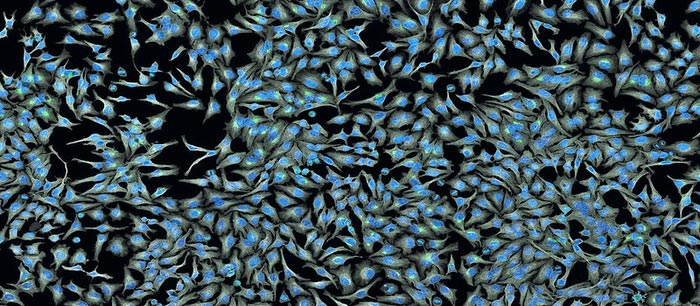New tumor cell tracking system aims to understand cancer treatment resistance

This photograph shows a panoramic view of HeLa cells, a cell line many researchers use to study a large variety of important research questions. The cells' nuclei containing the DNA are stained in blue and the cells' cytoskeletons in gray.
Credit: Tom Deerinck, National Center for Microscopy and Imaging Research
Despite tremendous advances in medicine, tumors are challenging to cure because they are made up of heterogeneous cells. Like human families, the individual cells of a tumor share some common traits and characteristics, but as the tumor expands, the cells also develop their own identities. And, as a result, some cells are more resistant to therapy than others and quicker to adapt and change.
A team of researchers at The University of Texas at Austin developed a new way to tag tumor cells to figure out how they evolve and change over time to resist cancer treatments. They studied chronic lymphocytic leukemia (CLL) primarily, but these findings could help researchers learn more about the entire spectrum of cancerous tumors.
“This is a technology that lets you replay the evolutionary history of the tumor,” said Amy Brock, an associate professor in the Cockrell School’s Department of Biomedical Engineering and co-lead author on a new paper published in Nature Cancer. “We can collect those pre-resistant cells and go back and look at what happened to them. We can try many parallel treatments and measure how specific cells respond and which ones persist.”
The ability to essentially “tag” nucleic acids — the genetic information of the cell such as RNA or DNA — to monitor them is not a brand-new technology. However, current capabilities don’t paint a full picture of how tumor cells evolve. What this platform, known as ClonMapper, can do that wasn’t possible before is look backward and trace how tumor cells change over time. That gives researchers the ability to look at which cells “win out” over less resistant cells, continue to clone themselves and make the tumor more dangerous. By isolating these cells, researchers can better test which treatments do and don’t work against them.
Monitoring changes over time is key to successful transfer treatments. Tumor cells adjust to treatments and become resistant. That’s why patients can go into remission, but later experience relapse.
“This is one of reasons cancer treatment is so challenging — we don’t have very good ways of predicting ahead of time which cells will be sensitive to a type of drug and which ones will be resistant,” Brock said. “This acquired resistance is a leading cause of treatment failure for many patients with cancer.”
CLL is a low-grade B-cell malignancy that is often monitored for months or even years before it requires active treatment. This “watch and wait” style of treatment relies heavily on accurate monitoring of the patient. In the study, ClonMapper focused on identifying which cells were cloning themselves, how fast this process happened and how it influences the growth rate of surrounding cells over time. This allowed a much more accurate analysis of the cell population and may enable more customized treatment plans for patients.
The ClonMapper study was led by researchers from UT Austin and the Dana-Farber Cancer Institute, Harvard Medical School and the Broad Institute. The UT Austin team includes from the Cockrell School and College of Natural Sciences Aziz M. Al’Khafaji, Eric Brenner, Kaitlyn E. Johnson and Russell E. Durrett.
The UT Austin team is now deploying ClonMapper to study several different cancer types. Brock’s lab recently received funding from the National Cancer Institute to study breast cancer and has an ongoing collaboration with Dell Medical School working on colorectal carcinoma treatments.
Journal: Nature Cancer
DOI: https://doi.org/10.1038/s43018-021-00222-8
Article Title: Multifunctional barcoding with ClonMapper enables high-resolution study of clonal dynamics during tumor evolution and treatment
Media Contact
Nat Levy
nat.levy@utexas.edu
All latest news from the category: Life Sciences and Chemistry
Articles and reports from the Life Sciences and chemistry area deal with applied and basic research into modern biology, chemistry and human medicine.
Valuable information can be found on a range of life sciences fields including bacteriology, biochemistry, bionics, bioinformatics, biophysics, biotechnology, genetics, geobotany, human biology, marine biology, microbiology, molecular biology, cellular biology, zoology, bioinorganic chemistry, microchemistry and environmental chemistry.
Newest articles

Security vulnerability in browser interface
… allows computer access via graphics card. Researchers at Graz University of Technology were successful with three different side-channel attacks on graphics cards via the WebGPU browser interface. The attacks…

A closer look at mechanochemistry
Ferdi Schüth and his team at the Max Planck Institut für Kohlenforschung in Mülheim/Germany have been studying the phenomena of mechanochemistry for several years. But what actually happens at the…

Severe Vulnerabilities Discovered in Software to Protect Internet Routing
A research team from the National Research Center for Applied Cybersecurity ATHENE led by Prof. Dr. Haya Schulmann has uncovered 18 vulnerabilities in crucial software components of Resource Public Key…





















